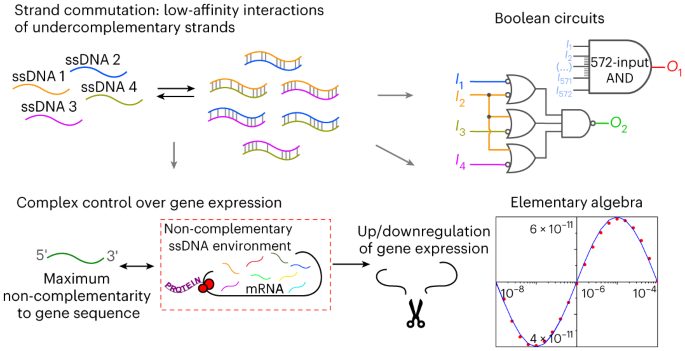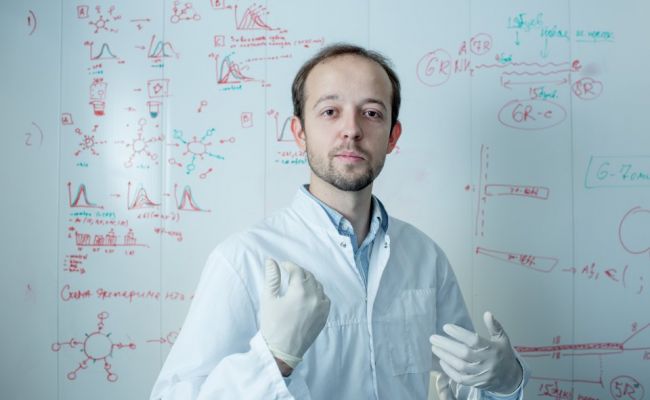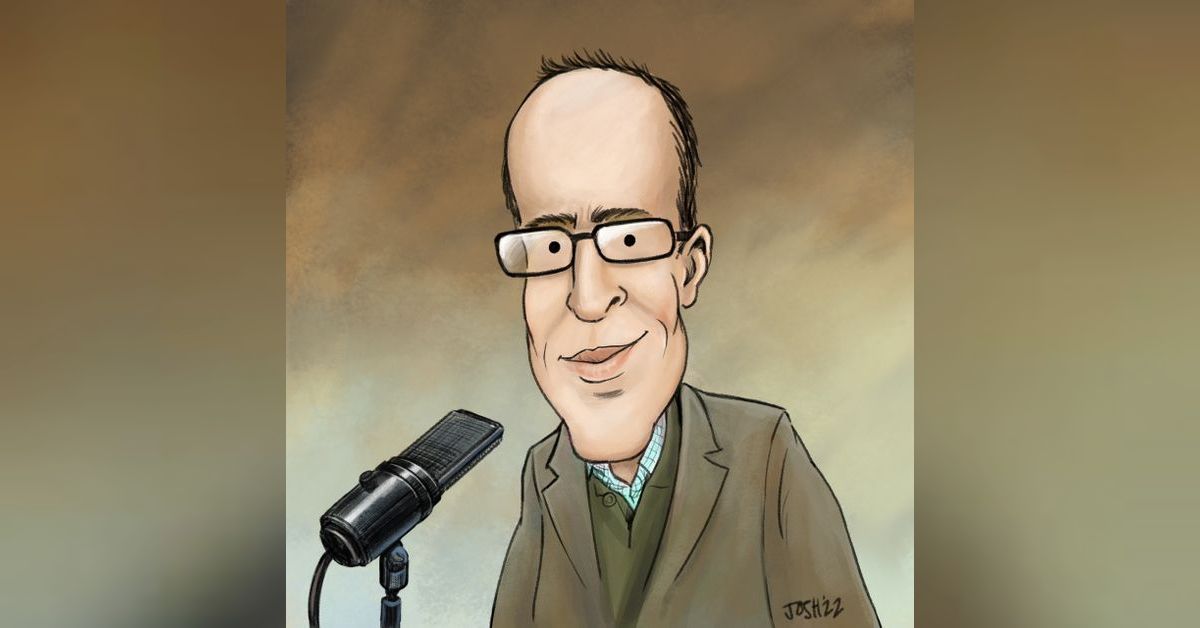Yesterday, on January 20, there was a news report on the Russian Channel 1tv.ru and a couple of other sites:

In the program, they say that after the publication, his email and telephone is busy with invitations to speak at conferences. (Okay, but I hope he stays safe.) Anyway, enthusiasm for something Russian is uplifting in a time when even Dostoevsky has been cancelled.
Somewhere else they say that geneticists used to think that double-stranded DNA was all that matters and that much was junk DNA. This research as I understand shows new functions of what was considered useless. He found pieces of genetic material in the cell that according to previous understanding shouldn't influence the expression of DNA at all, and showed that they do indeed strongly influence DNA.
In other words, we are finding that the complexity and intricacy of the cell is growing as our understanding increases, and we become capable of appreciating more.
To illustrate the significance of the discovery, they use the analogy of moving from understanding there is one Sun to understanding that the millions of stars are also suns.
Vesti.ru has a more comprehensive written report, including their own video presentation.

Here is an image from the Live Journal that in a way reflects some of the symbols in the article:

One of the uses they expect from the finding is to be able to understand so far unexplained side effects of medicine and vaccines.
Maybe the news will enter on RT or Sputnik one of these days, but since the EU is in RU media lockdown, all to share for now is the abstract from the Nature Chemistry issue: Non-complementary strand commutation as a fundamental alternative for information processing by DNA and gene regulation - Nature Chemistry
In all fairness, the article is not on the front page of the magazine. And maybe others view the importance different from how it is viewed in Russia. Perhaps also my perceptions are not clear, would I have been so enthusiastic about any other discovery from this issue of the magazine if presented favourably? Never mind, I learned something new about the complexity and wondrous working of the finest level of our physiology. And when I think how viruses consists of small pieces of DNA, their very presence in the cell might influence the biochemical communication and expression of the DNA including the loose bits and pieces already present, thus affecting change, even if the virus does not get directly integrated.
There is one old passage in the sessions, that @dugdeep reminded me about and even if this discovery does not cover it, maybe it is no longer so far away:

 cassiopaea.org
cassiopaea.org
If you follow the link, it should lead to the news report. Otherwise, it is segment two of 17 in the evening 21:00 news, in Russian and texted in Russian, but they do show clips of how the molecular machines work. In his research, he used optical tomography to help uncover the interactions of the small pieces of genetic material. Here is a screenshot from the presentation:Breakthrough discovery in world science: Russian scientist Maxim Nikitin discovered a new mechanism for storing information in DNA
An incredible breakthrough in world science, a step into a completely new era of biology, which was made by a single Russian! Maxim Nikitin, a scientist at Sirius University of Science and Technology, has discovered a new fundamental mechanism for storing information in DNA. And it may be the key to solving such mysteries as incurable diseases, the mechanisms of aging, and even the origin of life. So what is this' molecular switching', Peter Deryagin also learned.
In the program, they say that after the publication, his email and telephone is busy with invitations to speak at conferences. (Okay, but I hope he stays safe.) Anyway, enthusiasm for something Russian is uplifting in a time when even Dostoevsky has been cancelled.
Somewhere else they say that geneticists used to think that double-stranded DNA was all that matters and that much was junk DNA. This research as I understand shows new functions of what was considered useless. He found pieces of genetic material in the cell that according to previous understanding shouldn't influence the expression of DNA at all, and showed that they do indeed strongly influence DNA.
In other words, we are finding that the complexity and intricacy of the cell is growing as our understanding increases, and we become capable of appreciating more.
To illustrate the significance of the discovery, they use the analogy of moving from understanding there is one Sun to understanding that the millions of stars are also suns.
Vesti.ru has a more comprehensive written report, including their own video presentation.
A blogger on Live Journal also gave a summary, perhaps rewrites the above, but also adds more, probably from the abstract of the paper:Russian molecular biologist makes breakthrough discovery
Russian molecular biologist Maxim Nikitin has made a breakthrough discovery. He discovered a fundamental mechanism for storing information in DNA, as well as a related mechanism for controlling gene activity. His research forces us to reconsider the previous knowledge about DNA, which scientists have been guided by for the last 70 years.
In the middle of the XX century, the Englishman Francis Crick and the American James Watson discovered the structure of DNA and described it as a duplicated spiral. The links in this long and complex molecule are nucleotides that differ from each other in their nitrogenous base: Adenine, Thymine, Guanine and Cytosine. In DNA formulas, they are designated by the first letter. Nucleotides arranged one after another form a DNA chain. The second chain in the pair is not identical to the first, but is comparable according to a certain rule. Adenine binds to Thymine, Guanine binds to Cytosine.
This is the basis of the principle of complementarity. The DNA pattern is read by other molecules and triggers the formation of a variety of body properties: from eye color to intelligence. This mechanism formed the basis of our ideas about the transmission of hereditary information using DNA. Scientists were sure that the double helix was the main key to genes. But a large number of short DNA chains are still "cooked" in the "cellular broth". A small chain also controls the work of the gene. However, it used to be thought that this only happens if they are complementary.
Nikitin in his experiments showed for the first time that even if we take the most dissimilar DNA chain, it can, through interaction with other short chains, influence the work of the gene.
Maxim Nikitin, Head of the Nanobiomedicine department at Sirius University, Head of the Laboratory of Nanobiotechnology at MIPT, told: "The phenomenon that I discovered just shows that if we take a large pool of small DNA chains, between which there are no such clear, absolutely complementary interactions, i.e. when they are all different and do not uniquely correspond to each other in the only way, then such DNA has the ability to store a very large amount in its ensemble information and transmit it."
A new fundamental mechanism can be the key to understanding a wide variety of processes: from the causes of cancer, aging of the body to questions about the origin of life on Earth and evolution. In addition, the knowledge gained will give impetus to the development of gene therapy, and will also be able to increase the safety of DNA and RNA vaccines. Because it will become easier to detect and, accordingly, suppress adverse reactions to drugs during treatment.
There is a lot of work ahead with new knowledge.
A downside, is that it might allow ill intentioned governments, their military and corporations to fiddle with the DNA even more, but perhaps at the same time it will help to heal the damages too. The article continues:A scientist from Russia has made a fundamental discovery in the field of genetics
Maxim Nikitin, head of the Department of Nanobiomedicine at Sirius University and head of the MIPT laboratory, has discovered the mechanism of 'molecular switching' of DNA, which changes ideas in biology.
An open fundamental phenomenon can be the key to understanding the secrets of genetics, complex diseases, instant memory and aging before the emergence of life on Earth and its evolution. In addition, it will allow us to qualitatively improve the specificity of gene therapy and the safety of DNA/RNA vaccines by detecting and reducing adverse drug reactions during treatment.
Following this link led to:For more than 70 years, it was believed that DNA stores and processes information due to the structure of the double helix — uniquely corresponding to each other (complementary) molecular chains. Nikitin experimentally proved that for effective processing of genetic information, DNA does not necessarily need to form a double helix. DNA can store and transmit information due to weak affinity interactions, which occur when the molecules have a low 'affinity' for each other. Moreover, he showed that the so-called short DNA, even the most non-complementary to the gene, can regulate its work.
Maxim Nikitin noticed that in a mixture consisting of short single-stranded and non-complementary oligonucleotides, a variety of their complexes will simultaneously coexist. Variants of these interactions are determined by the' affinity ' of molecules and are generally described by the law of effective masses, which was discovered back in the 19th century, and which states that the reaction rate depends on the concentration of the substances involved. Such complexes will be bound to each other and will transmit information to each other, even if some two oligonucleotides do not bind to each other directly.
For example, in the simplest system of three oligonucleotides-X, A and B: if A and B do not interact with each other, they can still transmit information to each other through an intermediary-the' switch ' X. At the same time, each of them only needs to interact very weakly with X: an increase in the concentration of A will lead to an increase in the number of XA complexes, which will reduce the number of XB complexes, although A did not interact directly with B in any way. If the system contains a larger number of oligonucleotides, then a significant amount of information can be transmitted.
In order to prove that DNA can form sets of molecules with almost any pre-defined mutual affinities, in his article Maxim Nikitin shows the experimental implementation of a wide variety of systems that process information in different ways, starting with systems that include only three super-short oligonucleotides with a length of seven nitrogenous bases, to memory cells, systems for calculating the square distribution of the number of root, etc. At the same time, computer modeling of the switching phenomenon demonstrated stable information processing by a system consisting of 1,000 oligonucleotides. This allows you to create a 572-bit information processing cell, which exceeds the bit capacity of all existing electronic computers. It is noteworthy that the model proposed by Nikitin conceptually has no limit at all on the number of oligonucleotides interacting in this way.
In addition, the phenomenon discovered by Nikitin allowed him to experimentally show another surprising fact that does not fit into the modern paradigm of molecular biology: any unstructured single-stranded DNA can specifically regulate the expression of a given gene, regardless of their mutual complementarity. It all depends on the presence of other oligonucleotides (also non-complementary) in the environment or organism.
The discovered fundamental phenomenon of switching DNA strands is of great practical importance. It can improve the specificity of gene therapy and the safety of DNA / RNA vaccines by detecting and reducing the side effects of administered drugs. This requires, of course, the creation of a new generation of software that more accurately predicts the weak-affinity interaction of nucleic acids, as well as analyzes their involvement in various natural processes, taking into account the mechanism of molecular switching. But in the end, all this will help to minimize the risks of negative consequences of inappropriate editing of the patient's genome and reduce the number of adverse events during treatment.
The results of the study are published in one of the most respected scientific journals Nature Chemistry.
After the written abstract follows this image:Article Published: 05 January 2023
Non-complementary strand commutation as a fundamental alternative for information processing by DNA and gene regulation
Maxim P. Nikitin
Nature Chemistry volume 15, pages70–82 (2023) Cite this article
Abstract
- 2592 Accesses
- 1 Citations
- 35 Altmetric
- Metricsdetails
The discovery of the DNA double helix has revolutionized our understanding of data processing in living systems, with the complementarity of the two DNA strands providing a reliable mechanism for the storage of hereditary information. Here I reveal the ‘strand commutation’ phenomenon—a fundamentally different mechanism of information storage and processing by DNA/RNA based on the reversible low-affinity interactions of essentially non-complementary nucleic acids. I demonstrate this mechanism by constructing a memory circuit, a 5-min square-root circuit for 4-bit inputs comprising only nine processing ssDNAs, simulating a 572-input AND gate (surpassing the bitness of current electronic computers), and elementary algebra systems with continuously changing variables. Most importantly, I show potential pathways of gene regulation with strands of maximum non-complementarity to the gene sequence that may be key to the reduction of off-target therapeutic effects. This Article uncovers the information-processing power of the low-affinity interactions that may underlie major processes in an organism—from short-term memory to cancer, ageing and evolution.

Here is an image from the Live Journal that in a way reflects some of the symbols in the article:

One of the uses they expect from the finding is to be able to understand so far unexplained side effects of medicine and vaccines.
Maybe the news will enter on RT or Sputnik one of these days, but since the EU is in RU media lockdown, all to share for now is the abstract from the Nature Chemistry issue: Non-complementary strand commutation as a fundamental alternative for information processing by DNA and gene regulation - Nature Chemistry
In all fairness, the article is not on the front page of the magazine. And maybe others view the importance different from how it is viewed in Russia. Perhaps also my perceptions are not clear, would I have been so enthusiastic about any other discovery from this issue of the magazine if presented favourably? Never mind, I learned something new about the complexity and wondrous working of the finest level of our physiology. And when I think how viruses consists of small pieces of DNA, their very presence in the cell might influence the biochemical communication and expression of the DNA including the loose bits and pieces already present, thus affecting change, even if the virus does not get directly integrated.
There is one old passage in the sessions, that @dugdeep reminded me about and even if this discovery does not cover it, maybe it is no longer so far away:

Session 26 November 1994
November 26, 1994 Frank and Laura, Terry and Jan Q: Hello. A: Thank you for altering the board. {We had installed more punctuation marks} We worked on your psyches to get you to do that. Q: (L) Well, you didn't have to work on our psyches to get us to do it. It makes things faster for us...
Q: (L) Do any of these emotions that we have talked about that were generated by DNA breakdown, were any of these related to what Carl Sagan discusses when he talks about the "Reptilian Brain"?
A: In a roundabout way.
Q: (L) Okay, at the time this "Mark of Cain" came about, were there other humans on the planet that did not have this configuration?
A: It was added to all simultaneously.
Q: (L) How did they physically go about performing this act? What was the mechanism of this event, the nuts and bolts of it?
A: Are you ready? DNA core is as yet undiscovered enzyme relating to carbon. Light waves were used to cancel the first ten factors of DNA by burning them off. At that point, a number of physical changes took place including knot at top of spine. Each of these is equally reflected in the ethereal.
Q: (L) Is that all?
A: No. But, do you need more?




